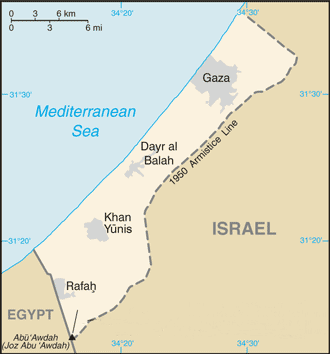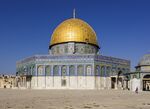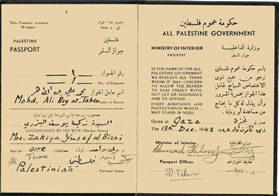محمية عموم فلسطين
محمية عموم فلسطين | |||||||||
|---|---|---|---|---|---|---|---|---|---|
| 1948–1959 | |||||||||
 | |||||||||
| المكانة | دولة عميلة لمملكة مصر معترف بها جزئياً | ||||||||
| العاصمة | القدس (المعلنة) مدينة غزة (بحكم الأمر الواقع 1948) القاهرة (بحكم الأمر الواقع 1949–59) | ||||||||
| اللغات الشائعة | اللهجة الفلسطينية | ||||||||
| الدين | الإسلام السني، المسيحية | ||||||||
| الحكومة | جمهورية | ||||||||
| الرئيس | |||||||||
• 1948 | أمين الحسيني | ||||||||
| رئيس الوزراء | |||||||||
• 1948 | أحمد حلمي عبد الباقي | ||||||||
| الحقبة التاريخية | الحرب الباردة | ||||||||
• تأسست | 22 سبتمبر 1948 | ||||||||
| 1949 | |||||||||
• الجامعة العربية تضع قطاع غزة تحت الرعاية الرسمية لمصر[1] | 1952 | ||||||||
• حل الحكومة (باستثناء منصب رئيس الوزراء)[2] | 1953 | ||||||||
| 1956 | |||||||||
• انحلت | 1959 | ||||||||
| Currency | الجنيه المصري | ||||||||
| |||||||||
| Today part of | قطاع غزة | ||||||||
محمية عموم فلسطين، تُعرف أيضاً باسم عموم فلسطين، محمية غزة، أو قطاع غزة، هي دولة عميلة قصرة العمر، ذات اعتراف محدود، كانت قائمة على منطقة قطاع غزة الحديثة، والتي تأسست بعد استيلاء مملكة مصر عليها أثناء حرب 1948 وكانت تُحكم كمحمية تحت قيادة حكومة عموم فلسطين. أُعلنت الحماية في 22 سبتمبر 1948 في مدينة غزة، وتشكلت حكومة عموم فلسطين. وكان رئيس الإدارة التي تتخذ من غزة مقراً لها هو الحاج أمين الحسيني، الرئيس السابق للجنة العربية العليا، بينما كان رئيس الوزراء هو أحمد حلمي باشا.[3] في ديسمبر 1948، بعد ثلاثة أشهر فقط من الإعلان، نُقلت حكومة عموم فلسطين إلى القاهرة ولم يُسمح لها أبدًا بالعودة إلى غزة، مما جعلها حكومة في المنفى. مع قرار آخر من الجامعة العربية بوضع قطاع غزة تحت الحماية الرسمية لمصر عام 1952، تجردت حكومة عموم فلسطين تدريجيًا من سلطتها. عام 1953، تم حل الحكومة اسميًا، على الرغم من أن رئيس الوزراء الفلسطيني حلمي باشا استمر في حضور اجتماعات الجامعة العربية نيابة عنها.[2] عام 1959 دُمجت المحمية قانونياً إلى الجمهورية العربية المتحدة، بينما أصبحت غزة فعلياً تحت الإدارة العسكرية المصرية.
هناك اختلافات في الرأي حول ما إذا كانت محمية عموم فلسطين مجرد دمية أو واجهة للاحتلال المصري، بتمويل مستقل أو نفوذ ضئيل، أو ما إذا كانت محاولة حقيقية لتأسيس دولة فلسطينية مستقلة. وعلى الرغم من أن حكومة عموم فلسطين ادعت سلطتها القضائية على كامل أراضي فلسطين الانتدابية البريطانية السابقة، إلا أن سلطتها القضائية الفعلية لم تمتد في أي وقت إلى ما هو أبعد من قطاع غزة، حيث ضمت الضفة الغربية إلى شرق الأردن، واحتفظت إسرائيل ببقية فلسطين. اعتمدت محمية عموم فلسطين بالكامل على الحكومة المصرية في التمويل وعلى الأونروا لتخفيف محنة اللاجئين الفلسطينيين في قطاع غزة. وخلال معظم فترة وجودها، كانت محمية عموم فلسطين تحت الإدارة المصرية بحكم الأمر الواقع، على الرغم من أن مصر لم تطالب بأي أراضي فلسطينية أو تضمها. ولم تعرض مصر الجنسية على الفلسطينيين في غزة. وتم إصدار جوازات سفر عموم فلسطين للفلسطينيين الذين يعيشون في قطاع غزة ومصر، ولم يُسمح لأولئك الذين يعيشون في قطاع غزة بالتنقل بحرية إلى مصر. ومع ذلك، لم تعترف بهذه الجوازات سوى ست دول عربية.
الاسم
According to Israeli academic Zvi Elpeleg, the term All-Palestine was coined to forestall any possible criticism by King Abdullah I of Jordan that the establishment of a Palestinian government meant acceptance of the partition plan.[4]
التاريخ
جزء من سلسلة عن |
|---|
| تاريخ فلسطين |
 |
| قبل التاريخ |
| التاريخ القديم |
| الفترة الكلاسيكية |
| الحكم الإسلامي |
| العصر الحديث |
|
|
مقدمة
Egypt supervised the government of Palestine in Gaza as a trustee on behalf of the Arab League.[5] An Egyptian Ministerial order dated 1 June 1948 declared that all laws in force during the Mandate would continue to be in force in the Gaza Strip. Another order issued on 8 August 1948 vested an Egyptian Administrator-General with the powers of the High Commissioner.
التأسيس
The protectorate was established in the Gaza enclave area captured by the Kingdom of Egypt during the 1948 Arab–Israeli War. All-Palestine was declared on 22 September 1948 in Gaza City, and the All-Palestine Government was formed. The Prime Minister of the Gaza-seated administration was Ahmed Hilmi Pasha and the President was Hajj Amin al-Husseini, former chairman of the Arab Higher Committee.[3] In December 1948, just three months after the declaration, the All-Palestine Government was relocated to Cairo and was never allowed to return to Gaza, making it a government in exile.
The Arab–Israeli War came to an end with the Israel-Egypt Armistice Agreement of 24 February 1949, which fixed the boundaries of the Gaza Strip.[6] The All-Palestine Government was not a party to the Agreement nor involved in its negotiation.
1948–1952
The All-Palestine Government was entirely relocated to Cairo in late October 1948 and became a government-in-exile, gradually losing any importance. Having a part in the All-Palestine Government, President al-Husseini also remained in exile at Heliopolis in Egypt throughout much of the 1950s.
التراجع والحل
With further resolution of the Arab League to put the Gaza Strip under the official protectorate of Egypt in 1952, the All-Palestine Government was gradually stripped of authority. In 1953, the government was nominally dissolved, though the Palestinian Prime Minister Hilmi continued to attend Arab League meetings on its behalf.[2] In 1959, the protectorate was de jure merged into the United Arab Republic, while de facto turning Gaza into military occupation area of Egypt.
الوضع القانوني
Ernest A. Gross, a senior U.S. State Department legal adviser, authored a memorandum for the United States government titled Recognition of New States and Governments in Palestine, dated 11 May 1948. He expressed the view that "The Arab and Jewish communities will be legally entitled on May 15, 1948 (the date of expiry of the British Mandate) to proclaim states and organize governments in the areas of Palestine occupied by the respective communities." Gross also said "the law of nations recognizes an inherent right of people lacking the agencies and institutions of social and political control to organize a state and operate a government."[7]
Though this is a generally accepted principle of international law, Gross' opinion was only internal US government advice. In any event, the British Mandate did expire on 15 May 1948. Other than the Arab Higher Committee, which was re-established in 1945 by the Arab League, the Palestinian Arab community had no government, and no administrative or unified military structure. It relied on the objective declared by the Arab League on 12 April 1948, and the expectation that the Arab armies would prevail over the Palestinian Jewish community. As the war progressed, however, the ineffectiveness of the Committee became obvious.
When it appeared that the Arab forces would not defeat the Israeli forces (and with King Abdullah I of Transjordan taking steps to annex the West Bank), fresh political measures were taken in the form of resurrecting the All-Palestine Government. By the end of the war, however, the Arab Higher Committee had become politically irrelevant.
There are differences of opinion as to whether the All-Palestine Protectorate was a mere puppet or façade of the Egyptian occupation, with negligible independent funding or influence, or whether it was a genuine attempt to establish an independent Palestinian state. Though the All-Palestine Government claimed jurisdiction over the whole former British Mandate of Palestine at no time did its effective jurisdiction extend beyond the Gaza Strip, with the West Bank annexed by Jordan and Israel holding the rest. The All-Palestine Protectorate relied entirely on the Egyptian government for funding and on UNRWA to relieve the plight of the Palestinian refugees in the Gaza Strip. The All-Palestine Government relocated to Cairo in late 1948, where it became a government in exile and gradually fell apart because of its impotence, four years later becoming a department of the Arab League. The protectorate finally dissolved in 1959 by decree of Nasser.
العلاقات الخارجية
الاعتراف
Egypt, which manipulated its formation, recognized All-Palestine on 12 October, followed by Syria and Lebanon on 13 October, Saudi Arabia the 14th and Yemen on the 16th. Iraq's decision to the same was made formally on the 12th, but was not made public. Both Great Britain and the US backed Jordan, the US saying that the mufti's role in World War II could be neither forgotten nor pardoned.[8]
Shortly thereafter, the Jericho Conference named King Abdullah I of Transjordan, "King of Arab Palestine".[9] The Congress called for the union of Arab Palestine and Transjordan and Abdullah announced his intention to annex the West Bank. The other Arab League member states opposed Abdullah's plan.
جوازات السفر
During most of its existence, the All-Palestine Protectorate was under de facto Egyptian administration, though Egypt never made any claim to or annexed any Palestinian territory. Egypt did not offer the Gazan Palestinians citizenship. Palestinians living in the Gaza Strip and Egypt were issued All-Palestine passports, and were not permitted to move freely into Egypt. However, these passports were only recognized by six Arab countries. The passports ceased to be issued when the All-Palestine Government was dissolved, though some countries continued to recognize them for some time.
الحكومة والسياسة
الحكومة
The All-Palestine Government was established by the Arab League on 22 September 1948 during the 1948 Arab–Israeli War to govern the All-Palestine protectorate. It was soon recognized by all Arab League members except Transjordan. Though jurisdiction of the Government was declared to cover the whole of the former Mandatory Palestine, its effective jurisdiction was limited to the All-Palestine Protectorate (Gaza Strip).[10] The Prime Minister of the Gaza-seated administration was Ahmed Hilmi Pasha, and the President was Hajj Amin al-Husseini, former chairman of the Arab Higher Committee.[3]
The new government had no administration, no civil service, no money, and no real army of its own. It formally adopted the Flag of the Arab Revolt that had been used by Arab nationalists since 1917 and revived the Holy War Army with the declared aim of liberating Palestine. The government was dissolved by Egypt in 1953, retaining only the Prime Minister office.[2]
المجلس الوطني
The All-Palestine National Council, officially Palestinian National Council (PNC).[11] was convened in Gaza on 1 October 1948,[11] under the chairmanship of Amin al-Husayni. The Council passed a series of resolutions culminating on 1 October 1948 with a declaration of independence over the whole of Palestine, with Jerusalem as its capital.[12] The council served the legislative arm of the All-Palestine Protectorate.
العسكرية
The All-Palestine Government revived the Holy War Army with the declared aim of "liberating Palestine". The Army, however, never actually recovered from the defeat of the 1947–1949 Palestine war and was in fact a collection of Palestinian fedayeen militias. The militias often engaged in armed attacks on Israeli border areas in what became known as the Palestinian Fedayeen insurgency.
الجغرافيا
The Gaza Strip was the only area of the former British Mandate territory that was under the nominal control of the All-Palestine Government. The rest of the British Mandate territory became either part of Israel or the West Bank, annexed by Transjordan (a move that was not recognized internationally, except by UK).
حل المحمية والتبعات
In 1959, the protectorate was de jure merged into the United Arab Republic, while de facto turning Gaza into a military occupation area of Egypt.
In 1957, the Basic Law of Gaza established a Legislative Council that could pass laws which were given to the High Administrator-General for approval.[13] In 1962, elections were held in the Egyptian-occupied Gaza and 22 Palestinian members were elected into the council.
انظر أيضاً
المصادر
- ^ Kumaraswamy, P.R. The A to Z of the Arab-Israeli Conflict. 2009. p. 15.
- ^ أ ب ت ث Oron, Yitzhak (September 7, 1960). "Middle East Record Volume 1, 1960". The Moshe Dayan Center – via Google Books.
- ^ أ ب ت Spencer C. Tucker, Priscilla Mary Roberts. The Encyclopedia of the Arab-Israeli Conflict: A Political, Social, and Military History: A Political, Social, and Military History p. 464
- ^ Elpeleg, Zvi (1 April 1989). "Why Was 'Independent Palestine' Never Created in 1948?". Israel Ministry of Foreign Affairs. Archived from the original on 2013-06-06. Retrieved 16 January 2022.
- ^ See Palestine and International Law, ed. Sanford R. Siverburg, McFarland and Company, 2002, ISBN 0-7864-1191-0, p. 11.
- ^ Egypt Israel Armistice Agreement Archived مايو 25, 2014 at the Wayback Machine UN Doc S/1264/Corr.1 23 February 1949
- ^ The memo is contained in the Foreign Relations of the United States 1948, volume 5, part 2, p 964 and is cited by Stefan Talmon, in Recognition of Governments in International Law (Oxford: Clarendon Press, 1998), p 36
- ^ Laurens 2007, pp. 167–169.
- ^ See Jericho Declaration, Palestine Post, December 14, 1948, Front page[dead link]
- ^ Gelber, Y. Palestine, 1948. Pp. 177–78
- ^ أ ب Elpeleg, Z. Why Was 'Independent Palestine' Never Created in 1948?. MFA. 01 April 1989.
- ^ Palestine Yearbook of International Law 1987-1988, Vol 4, by Anis F. Kassim, Kluwer Law International (1 June 1988), ISBN 90-411-0341-4, p 294
- ^ "From Occupation to Interim Accords", Raja Shehadeh, Kluwer Law International, 1997, pages 77–78; and Historical Overview, A. F. & R. Shehadeh Law Firm [1] Archived 2009-05-09 at the Wayback Machine
المراجع
- Laurens, Henry (2007). Une mission sacrée de civilisation. La Question de Palestine (in الفرنسية). Vol. 3. Paris: Fayard. ISBN 978-2-213-63358-9.
قراءات إضافية
- Shlaim, Avi (1990). "The rise and fall of the All-Palestine Government in Gaza." Journal of Palestine Studies. 20: 37–53.[2]
- Shlaim, Avi (2001). "Israel and the Arab Coalition." In Eugene Rogan and Avi Shlaim (eds.). The War for Palestine (pp. 79–103). Cambridge: Cambridge University Press. ISBN 0-521-79476-5
- Articles with dead external links from July 2017
- Short description is different from Wikidata
- Articles with hatnote templates targeting a nonexistent page
- CS1 الفرنسية-language sources (fr)
- محمية عموم فلسطين
- تاريخ قطاع غزة
- تاريخ مصر (1900–الحاضر)
- محميات سابقة
- دول عربية سابقة
- جمهوريات عربية
- دول ومناطق تأسست في 1949
- دول ومناطق انحلت في 1959
- تأسيسات 1948 في آسيا
- انحلالات 1959 في آسيا
- تأسيسات 1948 في مصر
- انحلالات 1959 في مصر
